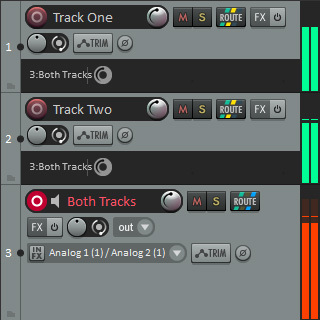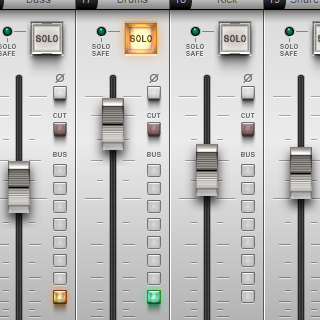macOS: 10.5 - 14.x (Intel and ARM64)
Linux:
- Requires GTK+3
GTK+2 supported with additional effort - Supports x86_64, i686, armv7l, aarch64
Using REAPER with your PC, Mac, or Linux computer, and no other software, you can import any audio and MIDI, synthesize, sample, compose, arrange, edit, mix, and master songs or any other audio projects.
If you add a hardware audio interface and a microphone, you have a complete professional quality recording studio, suitable for recording anything from a soloist to a band to an orchestra.
The best way to understand what REAPER can do is to try it for yourself. There is only one version of REAPER, used by home hobbyists and high-end professional studios alike. Evaluate the full version of REAPER with no obligation for up to 60 days.
The free User Guide and helpful user forum are always available if you need a hand.

Record and overdub audio and MIDI. The number of simultaneous recording inputs is limited only by your hardware.
Record directly to any of dozens of supported audio formats, at any sample rate or bit depth.
Any track can record audio or MIDI input, or record that track's processed audio or MIDI output.
Record multiple takes or layers, overdub, punch in and out, or record in a loop.
Record arm and disarm tracks without stopping playback.
Record directly to stereo, surround, or multichannel audio files, before or after effects processing.
Monitor inputs with or without software FX.
Set up multiple monitor mixes with separate FX processing.
Tape-style varispeed recording and playback.
Record simultaneously to multiple disks for redundancy and scalability.

Drag and drop to import, arrange, and render.
Freely mix audio, MIDI, video, still image media on any track.
Easily move, split, glue, resize, trim, loop, time stretch, pitch shift, fade, crossfade, slip, snap to grid, without switching tools.
Intuitive zoom, scroll, scrub, jog, tab to audio transient, MIDI navigation.
Simple and powerful nested folder system allows group editing, routing, bussing, all in one step.
Open multiple projects simultaneously in separate tabs.
Full automation recording, playback, and editing support for track and media item take controls and plug-ins.
Easily manage tempo, time signature, and varispeed changes.
Separate audio or MIDI into freely arrangeable takes and lanes for easy comping.
Easily copy or move regions, to quickly try out alternate arrangements.
Thorough and flexible multichannel support. Each track supports up to 128 individually routable channels and up to 128 MIDI buses.

Insert almost any third-party audio or MIDI plug-in or virtual instrument: VST, VST3, LV2, CLAP, DX (Windows only), AU (macOS only), JSFX.
Apply FX in real time, or non-destructively render FX output.
Includes the JSFX audio and midi plug-in scripting engine, and hundreds of user-programmable effects.
ReWire (audio and MIDI) any capable application for even more flexibility.
Automatic plug-in delay compensation (PDC).
Industry-leading performance and multiprocessor utilization.
Native bridging and firewalling: run 32-bit plug-ins in REAPER x64, maximize RAM utilization, protect against and recover from plug-in crashes.
Sidechain any plug-in, even if the plug-in does not natively support sidechaining.
Real-time pitch shifting, correction, and time stretch. Includes multiple pitch/timestretch engines including Elastique 3 Pro.
Two different multichannel/surround panners included, for spatial visualization and processing of stereo, surround, or multichannel audio (up to 128 channels per track).
Special-use plug-ins to virtualize outboard hardware, manage MIDI signals, stream audio, connect to NINJAM servers, and more.

Render tracks, regions, and media items in any combination. Render one file at a time, or thousands of files at once, with any channel count, sample rate, bit depth, bit rate, and encoding quality. Multiple sample rate conversion modes including Voxengo's r8brain-free.
Queue and save render instructions for batch rendering at a later time. Queued renders can be easily tweaked and re-rendered.
Optional dither, noise shaping, peak and LUFS/loudness normalization, brickwall true peak limiting, fade-in and fade-out.
Shareable, interactive HTML render statistics report including clip reporting and graphs of LUFS/loudness over time.
Customizable Region Render Matrix to render any number of specific tracks within any number of specific regions. Optionally force separate files to specific channel counts.
Unique wildcard system to automatically substitute any of dozens of attributes, including names of project resources, metadata, and technical file information, into rendered file names.
Support for many metadata formats, with wildcard substitution and support for embedded cover art or other image data.
Multi-core batch file conversion, including wildcard filename substitution and command-line support, to rapidly transcode many files at once.

Thoroughly customizable appearance - change colors, icons, toolbars, layouts, almost anything. Switch between multiple layouts as needed for different tasks.
REAPER's outboard windows can be shown, hidden, docked, or displayed on a separate monitor. Save and recall screensets for different tasks.
Almost anything that REAPER can do, literally thousands of actions, alone or in sequence, can be triggered by a keystroke, toolbar button, or external controller.
Easily extensible. Develop simple macros or complex extensions in Lua, EEL, or Python.
Deeply extensible. Includes an integrated development environment for composing, editing, and testing ReaScripts.

REAPER starts and loads fast - be ready to record in just a few seconds.
Nearly everything can be done on the fly while playing back or recording - adding/removing FX, editing, editing other project tabs.
Portable - put REAPER in your pocket and run it from a USB key or other removable media.
Tightly coded - installers are around 20 MB (a hundred times smaller than some other DAW software), updates usually install in less than a minute.
Rapid, efficient development - new features and optimizations are added quickly and often.
Very active, enthusiastic, and helpful user forum, get help quickly.
Fantastic and readable user-created user guide.
An honest business model that aims to provide the best possible user experience.
APEv2, ASWG, AXML, BWF, CAFINFO, CART, CUE, ID3, IFF, WAVINFO, iXML, VORBIS tags, WAVEFORMATEXTENSIBLE, XMP.
Image data (album art) can be embedded in FLAC and ID3 metadata.
Up to 128 MIDI input and 128 MIDI output hardware and/or loopback devices.
Outstanding multiprocessing capabilities for systems with 2 or more cores.
Generate or synchronize: SMPTE MTC, SMPTE LTC, MIDI Clock, or ASIO Positioning Protocol. Synchronize to JACK transport on Linux.
Configurable MIDI assignment for most track/transport controls, all plug-in controls, and any action or custom action.
Configurable 2-way OSC support.
Open control surface API; user-developed extensions available for other control surfaces.
Resolution, accuracy, and processing capabilities identical to any commercial plug-in.
Hundreds of JSFX plug-ins included with REAPER, including JSFX versions of real commercial plug-ins.
Fully user-scriptable, edit existing plug-ins or create your own from scratch.
Create and edit plug-ins on the fly, without interrupting audio playback.
JSFX integrated development environment included for composing, debugging, and testing.
Create plug-ins for anything: audio effects, utility tasks, one-offs, even visualizations and games.
Hundreds more user-created plugins available on the REAPER user forum and resource stash.
Just a few of the hundreds of included JSFX plugins:
Supported audio/MIDI processing and virtual instrument plug-in formats:
Pitch shift/time stretch engines included:
Built-in non-destructive spectral editing of media items.
All rate conversion and pitch shift/time stretch fully support multichannel audio.